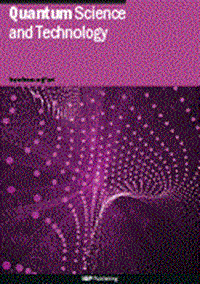Iterative quantum optimization of spin glass problems with rapidly oscillating transverse fields
IF 5
2区 物理与天体物理
Q1 PHYSICS, MULTIDISCIPLINARY
引用次数: 0
Abstract
In this work, we introduce a new iterative quantum algorithm, called Iterative Symphonic Tunneling for Satisfiability problems (IST-SAT), which solves quantum spin glass optimization problems using high-frequency oscillating transverse fields. IST-SAT operates as a sequence of iterations, in which bitstrings returned from one iteration are used to set spin-dependent phases in oscillating transverse fields in the next iteration. Over several iterations, the novel mechanism of the algorithm steers the system toward the problem ground state. We benchmark IST-SAT on sets of hard MAX-3-XORSAT problem instances with exact state vector simulation, and report polynomial speedups over Trotterized adiabatic quantum computation and the best known semi-greedy classical algorithm. When IST-SAT is seeded with a sufficiently good initial approximation, the algorithm converges to exact solution(s) in a polynomial number of iterations. Our numerical results identify a critical Hamming radius, or quality of initial approximation, where the time-to-solution crosses from exponential to polynomial scaling in problem size. This work proposes IST-SAT a new quantum algorithm, which improves upon solutions obtained from initial classical or quantum optimization algorithms. The steering mechanism we introduce through IST-SAT presents a new path toward achieving quantum advantage in optimization.具有快速振荡横向场的自旋玻璃问题的迭代量子优化
在这项工作中,我们引入了一种新的迭代量子算法,称为迭代交响隧道求解可满足性问题(IST-SAT),该算法利用高频振荡横向场解决量子自旋玻璃优化问题。IST-SAT作为一个迭代序列运行,其中一次迭代返回的位串用于在下一次迭代中设置振荡横向场的自旋相关相位。经过几次迭代,该算法的新机制将系统导向问题基态。我们用精确的状态向量模拟在一组硬MAX-3-XORSAT问题实例上对IST-SAT进行了基准测试,并报告了在Trotterized绝热量子计算和最著名的半贪婪经典算法上的多项式加速。当IST-SAT有足够好的初始近似时,算法在多项式次迭代中收敛到精确解。我们的数值结果确定了一个临界汉明半径,或初始近似的质量,其中解决时间在问题规模上从指数缩放到多项式缩放。这项工作提出了IST-SAT一种新的量子算法,它改进了从最初的经典或量子优化算法得到的解。我们通过IST-SAT引入的导向机制为实现优化中的量子优势提供了一条新的途径。
本文章由计算机程序翻译,如有差异,请以英文原文为准。
求助全文
约1分钟内获得全文
求助全文
来源期刊

Quantum Science and Technology
Materials Science-Materials Science (miscellaneous)
CiteScore
11.20
自引率
3.00%
发文量
133
期刊介绍:
Driven by advances in technology and experimental capability, the last decade has seen the emergence of quantum technology: a new praxis for controlling the quantum world. It is now possible to engineer complex, multi-component systems that merge the once distinct fields of quantum optics and condensed matter physics.
Quantum Science and Technology is a new multidisciplinary, electronic-only journal, devoted to publishing research of the highest quality and impact covering theoretical and experimental advances in the fundamental science and application of all quantum-enabled technologies.
 求助内容:
求助内容: 应助结果提醒方式:
应助结果提醒方式:


